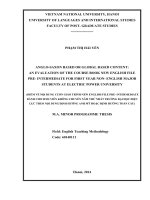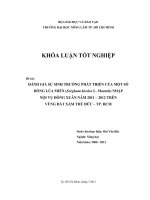Evaluation of elite sorghum [sorghum bicolor (L.) Moench] germplasm lines for morphological traits
Bạn đang xem bản rút gọn của tài liệu. Xem và tải ngay bản đầy đủ của tài liệu tại đây (104.87 KB, 4 trang )
Int.J.Curr.Microbiol.App.Sci (2019) 8(10): 2488-2491
International Journal of Current Microbiology and Applied Sciences
ISSN: 2319-7706 Volume 8 Number 10 (2019)
Journal homepage:
Short Communications
/>
Evaluation of Elite Sorghum [Sorghum bicolor (L.) Moench] Germplasm
Lines for Morphological Traits
Naveen Sihag*, Shubham Johari, Baishali Mishra,
P. K. Shrotria and P. K. Pandey
Department of genetics and plant breeding, Govind Ballabh Pant University of Agriculture
and Technology, Pantnagar- 263145, India
*Corresponding author
ABSTRACT
Keywords
Accessions, Genetic
diversity, Sorghum,
Morphological
traits, Races
Article Info
Accepted:
17 September 2019
Available Online:
10 October 2019
This study was performed at Instructional dairy farm, Govind Ballabh Pant
University of agriculture and technology during Kharif season, 2017 to
evaluate and characterize 96 sorghum accessions for various morphological
and fodder yield parameters. Highest Shannon index was recorded for races
(1.47) followed by glume color (1.33), ear head compactness (1.176) and
glume covering (1.117) revealed the greater variability for these qualitative
traits. The results of this study indicate that significant genetic diversity
exists among the sorghum accessions.
Introduction
Sorghum [Sorghum bicolor (L.) Moench] also
known as Jowar has originated in Africa about
5000 – 8000 years ago (De Candolle 1890).
Sorghum is the fifth most important cereal
crop providing food and fodder throughout the
world (Doggett 1988). It is adapted to a wider
range of stress conditions like salt and drought
and known as a high-energy, drought tolerant
crop because of its efficiency. It is planted in
those areas which are considered to be hot and
too dry for other cereals, because of its
tolerance to heat and drought stress
(Poehlman, 1987). Sorghum in general
possesses a wide range of genetic variability.
Adequate variability provides options from
which selections are made for improvement
and possible hybridization.
Introgression of new genetic diversity through
hybridization with selected germplasm is one
way to increase genetic variation in breeding
populations, the base upon which gain from
selection depends (Guedira et al., 2000).
This study was conducted to classify the
germplasm on the basis of frequency of visual
characters. Different characters have different
states of expression.
2488
Int.J.Curr.Microbiol.App.Sci (2019) 8(10): 2488-2491
Materials and Methods
Results and Discussion
The present study was conducted at the
Instructional Dairy Farm of the Govind
Ballabh Pant University of Agriculture and
Technology, Pantnagar, Uttarakhand, India
during Kharif 2017. 96 germplasm accessions
were used for the study and planted in an
Augmented Block Design. Each genotype
were sown in two rows of 3 metre length with
a row spacing of 45cm. Recommended
package of practices were followed to grow
the normal healthy crop. An average rainfall
of 948.6mm is experienced annually. Data was
recorded on different types of morphological
traits of 96 germplasm lines.
An evaluation was done to classify the
sorghum germplasm on the basis of
morphological traits into different categories.
Sorghum has a wide range of variability, it has
five different races viz., bicolor, kafir, durra,
caudatum
and
guinea.
Morphological
characters have different states of expression
and the number of plants coming under the
different categories is calculated in this study.
Frequency percentage and Shannon index is
calculated. Higher value of Shannon index
reveals greater variability in these qualitative
traits. The observations are presented in the
Table 1.
Table.1 Classification of Sorghum germplasm on the basis of frequency of visual characteristics
S.
No.
1
Characteristics
Leaf pigmentation
2
Leaf colour
3
Mid rib colour
4
Ear head shape
5
Ear head
compactness
6
Glume colour
7
Glume covering
8
Presence of awns
States of expression
Tan
Non tan
Light green
Medium green
Dark green
White
Green
Pyramidal
Symmetric
Panicle broader in upper part
Panicle broader in lower part
Loose
Semi loose
Semi compact
Compact
Grayed yellow
Grayed orange
Grayed red
Grayed purple
Short(50% of grain covered)
Medium (75% of the grain
covered)
Long (100% of the grain covered)
Very long (longer than the grain)
Present
2489
No. of
genotypes
57
39
16
48
42
40
56
30
55
3
8
28
4
20
44
16
36
26
18
5
25
52
14
Frequency
%
Shannon
index
59.3
40.6
0.675
16.66
39.5
43.7
1.027
41.66
58.33
0.679
31.25
57.29
3.12
8.33
0.997
29.16
4.16
20.83
45.83
1.176
16.66
37.5
27.08
18.75
1.334
5.20
26.04
54.16
14.58
1.117
27
28.12
0.594
Int.J.Curr.Microbiol.App.Sci (2019) 8(10): 2488-2491
9
Seed colour
10
Seed lusture
11
Race
Absent
Grayed yellow
Grayed orange
Grayed purple
Lustrous
Non lustrous
Bicolor
Caudatum
Guinea
Kafir
Durra
69
36
37
23
50
46
13
39
20
14
10
Highest Shannon index was recorded for races
(1.47) followed by glume color (1.33), ear
head compactness (1.176) and glume covering
(1.117). A diversity index is a quantitative
measure that reflects how many different types
there are in a dataset. It is most often
calculated as follows:
H’=
In ecology, pi is often the proportion of
individuals belonging to the ith species in the
dataset of interest.
Dong et al., 2001, Tatineni et al., 1996,
Ghafoor et al., 2002 and Malik et al., 2011
also observed wide range of variability for
morphological characters.
Conflict of interest
The authors declare that they have no conflict
of interest.
References
De Candolle, A., 1884. Origin of Cultivated
Plants, Hafner Publishing Company,
New York.
Doggett, H. 1988. Sorghum. Longman
Scientific, and Technical, London.
71.87
37.5
38.54
23.95
1.077
52.08
47.91
0.692
13.54
40.62
20.83
14.58
10.41
1.479
Dong, Y.S., B.C. Zhuang, L.M. Zhao, H.Sun
and M.Y. He. 2001. The genetic
diversity of annual wild soybeans
grown in China. Theor. Appl Genet.,
103: 98-103.
Ghafoor, A., Ahmad, Z., Qureshi, A. S. and
Bashir, M. 2002. Genetic relationship
in Vigna mungo (L.) Hepper and V.
radiata (L.) R. Wilczek based on
morphological traits and SDSPAGE. Euphytica, 123(3), 367-378.
Guedira, G.L.B., J.A. Thompson, R.L. Nelson
and M.L. Warburton. 2000. Evaluation
of genetic diversity of soybean
introductions and North American
ancestors using RAPD and SSR
markers. Crop Sci., 40: 815-823.
Malik, M. F. A., Ashraf, M. U. H. A. M. M.
A. D., Qureshi, A. S. and Khan, M. R.
2011. Investigation and comparison of
some morphological traits of the
soybean populations using cluster
analysis. Pak. J. Bot, 43(2), 12491255.
Poehlman, J. M. 1987. Breeding sorghum and
millet. In Breeding field crops (pp.
508-555). Springer, Dordrecht.
Tatineni, V., Cantrell, R. G. and Davis, D. D.
1996. Genetic diversity in elite cotton
germplasm
determined
by
morphological characteristics and
RAPDs. Crop Science, 36(1), 186-192.
2490
Int.J.Curr.Microbiol.App.Sci (2019) 8(10): 2488-2491
How to cite this article:
Naveen Sihag, Shubham johari, Baishali mishra, P. K. Shrotria and Pandey, P. K. 2019.
Evaluation of Elite Sorghum [Sorghum bicolor (L.)Moench] Germplasm Lines for
Morphological Traits. Int.J.Curr.Microbiol.App.Sci. 8(10): 2488-2491.
doi: />
2491






![Mapping of quantitative trait loci (QTLS) associated with sugarcane aphids resistance in recombinant inbreed population of sorghum [Sorghum bicolor (L.) Moench]](https://media.store123doc.com/images/document/2020_01/09/medium_jrk1578566578.jpg)
![Development of an in vitro regeneration system in Sorghum [Sorghum bicolor (L.) Moench] using root transverse thin cell layers (tTCLs)](https://media.store123doc.com/images/document/2020_01/09/medium_nfv1578574721.jpg)

![Combining ability studies in forage sorghum [Sorghum bicolour (L.) Moench] for yield and quality parameters](https://media.store123doc.com/images/document/2020_01/09/medium_uoj1578577680.jpg)